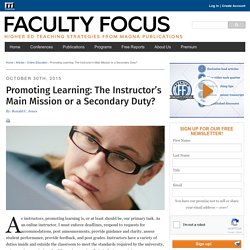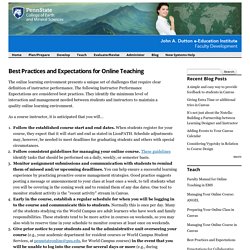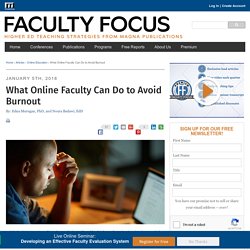

Excerpted from Netiquette by Virginia Shea. The Core Rules of Netiquette are excerpted from the book Netiquette by Virginia Shea.

Click on each rule for elaboration. Best Practices in Online Teaching Strategies. Five Ways to Help Students Succeed in the Online Classroom. Avoiding the Trap of the Info Dump for Online Course Announcements. It’s the night before a major assignment is due and you sit down to post an announcement in your online course.

You want to remind your students of the impending due date, and oh yes, there’s a great webinar offered by the career center coming up on Tuesday. That reminds you, there’s also that article about the history of Wikipedia that you want to share with them too. Come to think of it, now’s as good a time as any to discuss the lack of analysis you noticed in their discussion board posts last week. As you write about their discussions, you also decide to include one last link to a citation website you hope will help them improve in this area. Ten Principles of Effective Online Teaching. Promoting Learning: Main Mission or a Secondary Duty? As instructors, promoting learning is, or at least should be, our primary task.

As an online instructor, I must enforce deadlines, respond to requests for accommodations, post announcements, provide guidance and clarity, assess student performance, provide feedback, and post grades. Instructors have a variety of duties inside and outside the classroom to meet the standards required by the university, yet our primary mission should remain ensuring that students are gaining new knowledge. In the online classroom environment, the instructor has the opportunity to remain faceless, detached, and a distant enforcer of classroom etiquette, academic integrity, and grading standards.
Such a teaching model might allow an instructor to remain employed, yet one might consider the negative effect on student engagement and motivation, communication flow, and the overall learning environment. Below are a few strategies that help promote learning as our primary mission: Ronald C. Best Practices and Expectations for Online Teaching. The online learning environment presents a unique set of challenges that require clear definition of instructor performance.

The following Instructor Performance Expectations are considered best practices. They identify the minimum level of interaction and management needed between students and instructors to maintain a quality online learning environment. As a course instructor, it is anticipated that you will… Follow the established course start and end dates. Managing Your Online Class: ANGEL. The following material is geared toward ANGEL users.

We are working on updating this information to accommodate Canvas users. If you have questions, please contact your learning designer. Quick Links Several Weeks (or more!) Classroom Management of an Online First-Year Experience Course. A student’s initial introduction into higher education can be exciting and frustrating, especially when the student is enrolled in their first online class.

This year I taught a newly created first-year experience course at a vocational based higher education institution. The course had initial enrollments of 25 and 63 students respectively across the two-semester period. Now, I know these numbers are high (especially the course with 63 students), but after the first seven days of the add/drop period, the class size diminished. The course drop rate was 20% (5 students dropped out of 25) and 23.8% (15 students dropped out of 63) after the add/drop period of each semester. What Online Faculty Can Do to Avoid Burnout. January 5th, 2018 By: Edna Murugan, PhD, and Noura Badawi, EdD With the increase in online classes being offered by higher education institutions and the convenience and flexibility it affords (particularly for adult learners), it is important that institutions hire, train, and retain high-quality, student-centric online faculty.

Just like on-ground students, online students need instructors who are passionate, organized, creative, and manage the (virtual) classroom effectively. Using Student Analytics for Online Course Improvement. Many instructors feel that they need to be experts in mathematics in order to understand analytics.

Instructor Presence: How to Keep from Going MIA in Your Online Course. February 3rd, 2017 By: Steve Dwinnells, PhD As an adjunct professor and one who works daily with faculty in helping them understand online education, I have noticed and heard of increasing numbers of professors going missing in action (MIA) while teaching their online course.

This is particularly disturbing since engagement is the number one characteristic that faculty must strive for when teaching from a distance. How to Add the Human Element to Online Learning. The online classroom can sometimes feel like a lonely place due to a lack of presence of the instructor and other students.

This lack of presence can negatively affect learning and lead to student attrition. Fortunately, some relatively simple measures can significantly add the essential human element to online courses. Avoiding the Trap of the Info Dump for Online Course Announcements. Guide: Core Rules of Netiquette. Learning@CSU Guide Netiquette, or network etiquette, is concerned with the "proper" way to communicate in an online environment. Consider the following "rules," adapted from Virginia Shea's The Core Rules of Netiquette, whenever you communicate in the virtual world. Rule 1: Remember the Human. OnlineCourseFacilitationChecklist 7 26 2013. OnlineTeachingCompetencies. Reduce Online Course Anxiety with a Check-in Quiz. “Online classes are often intimidating for first-time students,” writes David St Clair.
“They wrestle with the gnawing fear that their class has no anchor in the physical world and that there will be no one there to address their fears and concerns.” (p. 129) His solution? A simple, online check-in quiz. Here’s how the activity unfolds. The first assignment in the online course, to be completed on the first day, is this required check-in quiz. Based on his experience, here’s an abbreviated set of features St Clair has found contribute to the success of this activity.
Require the quiz – It’s a graded assignment, not something students do for extra credit. The check-in quiz doesn’t eliminate all the anxiety new (and not-so-new) students experience—it’s not magic, according to St Clair. Ten Online Teaching Tips You May Not Have Heard. At a time when online institutions are in fierce competition for students and accreditation agencies are taking a critical look at online course quality, it is becoming increasingly important for online instructors to ensure that they are exceeding their institution’s expectations.
Students are also expecting more from their online courses. And while most of us know the importance of addressing students by name in the discussion board and offering students substantive feedback on assignments, there many more things we can do. In this article, I outline 10 online teaching tips that may be less well-known but can lead to a more positive experience for both professor and student. 1. Communicate Information Using Multiple Channels – If you have important information to convey to students, don’t use just one channel of communication, use multiple. 2. 3. 4. 5. 6. In what ways, if any, did writing this paper change your views about the topic? 7. 8. 9. 10. Dr. 25 Tips For Successful Online Course Facilitation - eLearning Industry. Ten Tips for Effective Online Facilitation.
A Checklist for Facilitating Online Courses - Faculty Focus. There are two common assumptions about teaching online that can sink even the most well-meaning neophyte. One is that “teaching is teaching” regardless of whether it’s face-to-face or online and there’s no reason to deviate from the proven principles that work so well in the traditional classroom. The second assumption is that teaching online is all about the technology, and if you design your course properly, it pretty much runs itself. FacilitationOnlineWeb. Ten Tips for Effective Online Facilitation.